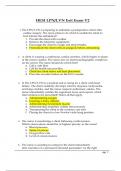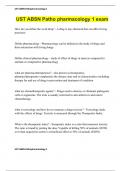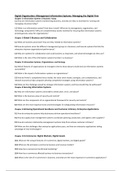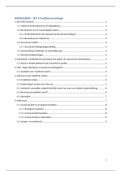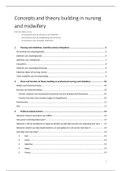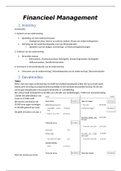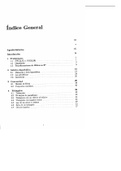MEMORY
The multi-store model of memory: sensory register, short-term memory and
long-term memory. Features of each store: coding, capacity and duration.
Coding: The format the information is stored as.
Capacity: How much information can be stored.
Duration: How long the information is stored for.
The working memory model: central executive, phonological loop, visuo-
spatial sketchpad and episodic buffer. Features of the model: coding and
capacity.
Central executive: Component that filters and co-ordinates the various components
of working memory
Phonological loop: System that deals with information coded in auditory (sound –
particularly words) format
Phonological store: A short-term store that briefly retains words and the order they
appeared in (sometimes called the inner ear)
Articulatory loop: Repeats (rehearses) words to keep them within the phonological
loop (sometimes called the inner voice)
Visuo-spatial sketchpad: The mind’s inner eye – it stores visual and spatial
information. Information within the visuo-spatial sketchpad is coded as mental
pictures.
Episodic buffer: A temporary store for information coded in all forms (auditory,
visual, etc.).
Types of long-term memory: episodic, semantic, procedural.
Episodic memory: Episodic long-term memory covers the story of our lives – things
like memories of specific events and the order they occurred in
Semantic memory: Semantic long-term memory covers meaning, understanding,
and general knowledge.
Procedural memory: Procedural long-term memory covers how to do things –
actions, skills, abilities, etc
Explanations for forgetting: proactive and retroactive interference and retrieval
failure due to absence of cues.
Interference: Interference is when existing information stored in memory disrupts
recall, and can be either proactive or retroactive:
Proactive interference: Proactive interference is when older information interferes
with your ability to remember something newer.
,Retroactive interference: Retroactive interference is the reverse of proactive
interference: It’s when newer information gets disrupted by older information
Context-dependent failure: Context-dependent failure is when the external
environment does not provide the cues necessary to recall a memory.
State-dependent failure: State-dependent failure is when the internal environment
during recall is different from the internal environment when the memory was coded.
Improving the accuracy of eyewitness testimony, including the use of the
cognitive interview.
Context Reinstatement: Trying to mentally recreate an image of the situation,
including details of the environment, such as the weather conditions, and the
individual’s emotional state, including their feelings at the time of the incident. This
makes memories accessible and provides emotional and contextual cues.
Recall from a Changed Perspective: Trying to mentally recreate the situation from
different points of view, e.g., describing what another witness present at the scene
would have seen. This is done to disrupt the effect that schemas have on recall.
Recall in Reverse Order: The witness is asked to describe the scene in a different
chronological order, e.g., from the end to the beginning. Our recollections are biased
by schemas, and if you recall the events starting from the end, this prevents your
pre-existing schema.
Report Everything: The interviewer encourages the witness to report all details
about the event, even though these details may seem unimportant. Memories are
interconnected so that recollection of one item may then cue a whole lot of other
memories.
, MEMORY
The multi-store model of memory: sensory register, short-term memory and
long-term memory. Features of each store: coding, capacity and duration.
AO1: MULTI STORE MODEL
The 3 stores are the sensory memory (SM), the short-term memory (STM) and the
long-term memory (LTM).
The sensory memory has several stores called sensory registers (SR) with each
processing information from a particular sense. The iconic register processes vision,
the echoic register process sound and the haptic register process touch.
Information received is raw and unprocessed and the sensory register has a large
capacity however the duration of storage is milliseconds unless given focused
attention in which case it will move to the short-term memory store.
Rehearsal maintains information in the short-term memory store however it is still
vulnerable to being forgotten due to limited duration (decay) or being displaced by
new incoming information due to limited capacity (displacement).
If rehearsed and processed deep enough (e.g. through elaborative or maintenance
rehearsal) the information then passes to the long-term memory store (LTM) which
has unlimited capacity and unlimited duration dependent on the level of processing
of the information received.
While encoding for the long-term memory is mainly semantic and based on meaning,
the short-term memory encodes acoustically with a capacity of 7 +/- 2 items and a
duration of up to 18 seconds.
AO3: MULTI STORE MODEL
Research evidence by Glanzer et al demonstrated support for short-term and
long-term memory being different stores. Participants were tasked with
recalling word lists with earlier and later words more likely to be recalled and
this was known as the ‘primacy’ and ‘recency’ effect. This primacy effect
occurs as the first words are transferred to long-term memory while the
recency effect occurs as the last words are still within the short-term memory.
Delays of 10 seconds or more before recall resulted in only a primacy effect
with only long-term memory affected. This highlighted the difference in short-
term memory and long-term memory, supporting the theory.
A major strength of this model is the model’s predictions around memory
which can be easily tested to verify whether it applies to human behaviour.
The prefrontal cortex is seen to relate to short-term memory while the
hippocampus is associated with longterm memory, supporting the model’s
idea of different memory stores.
Shallice et al highlighted this with a case study of KF who suffered brain
damage resulting in difficulty with verbal information in short-term memory but
normal ability with visual information. This highlights how short-term memory
is not a single store as the MSM suggests.
The multi-store model of memory: sensory register, short-term memory and
long-term memory. Features of each store: coding, capacity and duration.
Coding: The format the information is stored as.
Capacity: How much information can be stored.
Duration: How long the information is stored for.
The working memory model: central executive, phonological loop, visuo-
spatial sketchpad and episodic buffer. Features of the model: coding and
capacity.
Central executive: Component that filters and co-ordinates the various components
of working memory
Phonological loop: System that deals with information coded in auditory (sound –
particularly words) format
Phonological store: A short-term store that briefly retains words and the order they
appeared in (sometimes called the inner ear)
Articulatory loop: Repeats (rehearses) words to keep them within the phonological
loop (sometimes called the inner voice)
Visuo-spatial sketchpad: The mind’s inner eye – it stores visual and spatial
information. Information within the visuo-spatial sketchpad is coded as mental
pictures.
Episodic buffer: A temporary store for information coded in all forms (auditory,
visual, etc.).
Types of long-term memory: episodic, semantic, procedural.
Episodic memory: Episodic long-term memory covers the story of our lives – things
like memories of specific events and the order they occurred in
Semantic memory: Semantic long-term memory covers meaning, understanding,
and general knowledge.
Procedural memory: Procedural long-term memory covers how to do things –
actions, skills, abilities, etc
Explanations for forgetting: proactive and retroactive interference and retrieval
failure due to absence of cues.
Interference: Interference is when existing information stored in memory disrupts
recall, and can be either proactive or retroactive:
Proactive interference: Proactive interference is when older information interferes
with your ability to remember something newer.
,Retroactive interference: Retroactive interference is the reverse of proactive
interference: It’s when newer information gets disrupted by older information
Context-dependent failure: Context-dependent failure is when the external
environment does not provide the cues necessary to recall a memory.
State-dependent failure: State-dependent failure is when the internal environment
during recall is different from the internal environment when the memory was coded.
Improving the accuracy of eyewitness testimony, including the use of the
cognitive interview.
Context Reinstatement: Trying to mentally recreate an image of the situation,
including details of the environment, such as the weather conditions, and the
individual’s emotional state, including their feelings at the time of the incident. This
makes memories accessible and provides emotional and contextual cues.
Recall from a Changed Perspective: Trying to mentally recreate the situation from
different points of view, e.g., describing what another witness present at the scene
would have seen. This is done to disrupt the effect that schemas have on recall.
Recall in Reverse Order: The witness is asked to describe the scene in a different
chronological order, e.g., from the end to the beginning. Our recollections are biased
by schemas, and if you recall the events starting from the end, this prevents your
pre-existing schema.
Report Everything: The interviewer encourages the witness to report all details
about the event, even though these details may seem unimportant. Memories are
interconnected so that recollection of one item may then cue a whole lot of other
memories.
, MEMORY
The multi-store model of memory: sensory register, short-term memory and
long-term memory. Features of each store: coding, capacity and duration.
AO1: MULTI STORE MODEL
The 3 stores are the sensory memory (SM), the short-term memory (STM) and the
long-term memory (LTM).
The sensory memory has several stores called sensory registers (SR) with each
processing information from a particular sense. The iconic register processes vision,
the echoic register process sound and the haptic register process touch.
Information received is raw and unprocessed and the sensory register has a large
capacity however the duration of storage is milliseconds unless given focused
attention in which case it will move to the short-term memory store.
Rehearsal maintains information in the short-term memory store however it is still
vulnerable to being forgotten due to limited duration (decay) or being displaced by
new incoming information due to limited capacity (displacement).
If rehearsed and processed deep enough (e.g. through elaborative or maintenance
rehearsal) the information then passes to the long-term memory store (LTM) which
has unlimited capacity and unlimited duration dependent on the level of processing
of the information received.
While encoding for the long-term memory is mainly semantic and based on meaning,
the short-term memory encodes acoustically with a capacity of 7 +/- 2 items and a
duration of up to 18 seconds.
AO3: MULTI STORE MODEL
Research evidence by Glanzer et al demonstrated support for short-term and
long-term memory being different stores. Participants were tasked with
recalling word lists with earlier and later words more likely to be recalled and
this was known as the ‘primacy’ and ‘recency’ effect. This primacy effect
occurs as the first words are transferred to long-term memory while the
recency effect occurs as the last words are still within the short-term memory.
Delays of 10 seconds or more before recall resulted in only a primacy effect
with only long-term memory affected. This highlighted the difference in short-
term memory and long-term memory, supporting the theory.
A major strength of this model is the model’s predictions around memory
which can be easily tested to verify whether it applies to human behaviour.
The prefrontal cortex is seen to relate to short-term memory while the
hippocampus is associated with longterm memory, supporting the model’s
idea of different memory stores.
Shallice et al highlighted this with a case study of KF who suffered brain
damage resulting in difficulty with verbal information in short-term memory but
normal ability with visual information. This highlights how short-term memory
is not a single store as the MSM suggests.


